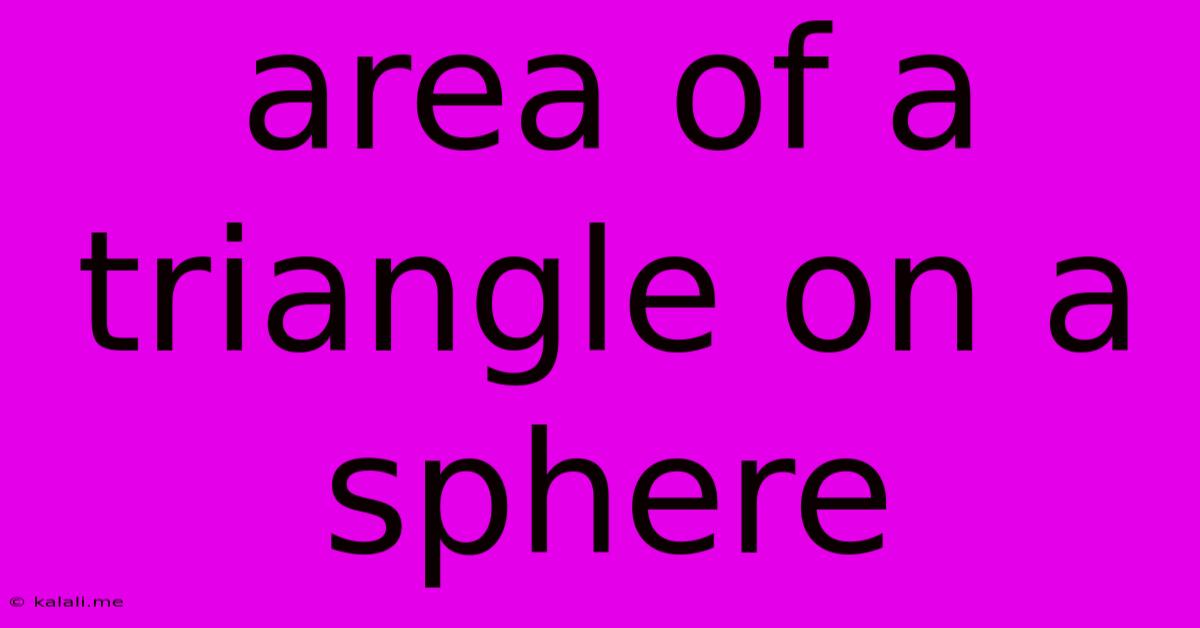Area Of A Triangle On A Sphere
Kalali
May 28, 2025 · 3 min read

Table of Contents
Calculating the Area of a Spherical Triangle: A Comprehensive Guide
The area of a triangle on a flat plane is a simple formula learned early in geometry: ½ * base * height. However, calculating the area of a triangle on a sphere is significantly more complex. This is because the geometry of a sphere differs fundamentally from Euclidean geometry. This article will guide you through the process of calculating this area, explaining the necessary concepts and providing a clear, step-by-step approach. Understanding this concept is crucial in fields like geodesy, cartography, and astronomy.
Understanding Spherical Geometry
Before diving into the area calculation, it's important to grasp some key concepts of spherical geometry. Unlike a flat plane, the surface of a sphere is curved. This curvature affects the properties of lines and angles. In spherical geometry:
- Great Circles: The "straight lines" on a sphere are actually segments of great circles. A great circle is a circle on the sphere whose center coincides with the center of the sphere. Think of the equator or lines of longitude.
- Spherical Angles: Angles are formed by the intersection of two great circles. These angles are measured in the plane tangential to the sphere at the point of intersection.
- Spherical Triangles: A spherical triangle is formed by the intersection of three great circles. The sides of a spherical triangle are arcs of great circles.
The Formula: Girard's Theorem
The area of a spherical triangle is elegantly given by Girard's Theorem. This theorem states that the area A of a spherical triangle is proportional to the excess of the sum of its angles over 180 degrees (π radians). The formula is expressed as:
A = R² (α + β + γ - π)
Where:
- A: The area of the spherical triangle.
- R: The radius of the sphere.
- α, β, γ: The three angles of the spherical triangle (in radians).
- π: Pi (approximately 3.14159).
Step-by-Step Calculation
Let's break down how to use Girard's Theorem with a practical example:
-
Measure the Angles: First, carefully measure the three angles (α, β, γ) of your spherical triangle. Remember these measurements must be in radians. You can convert degrees to radians using the conversion factor: Radians = Degrees * (π/180).
-
Sum the Angles: Add the three angles together: α + β + γ.
-
Calculate the Angle Excess: Subtract π (or 180 degrees) from the sum of the angles: (α + β + γ) - π. This result is the spherical excess.
-
Apply Girard's Theorem: Multiply the spherical excess by the square of the sphere's radius (R²): A = R² * ((α + β + γ) - π).
-
Units: Ensure consistent units throughout the calculation. If R is in meters, the area A will be in square meters.
Practical Applications and Considerations:
Girard's Theorem has numerous practical applications across various fields:
- Geodesy: Determining the area of land parcels on the Earth's surface.
- Cartography: Calculating the area of regions on maps projected onto a sphere.
- Astronomy: Estimating the surface area of celestial bodies.
Remember that the accuracy of the calculated area depends heavily on the accuracy of the angle measurements. Small errors in angle measurement can lead to significant errors in the calculated area, especially for smaller triangles.
Conclusion:
Calculating the area of a spherical triangle might seem daunting initially, but understanding Girard's Theorem simplifies the process. By following the steps outlined above and paying close attention to units and precision, you can accurately determine the area of any spherical triangle. This knowledge opens doors to a deeper understanding of spherical geometry and its wide-ranging applications.
Latest Posts
Latest Posts
-
Can You Lay Vinyl Flooring Over Tile
May 30, 2025
-
How Do You Find Your Whatsapp Number
May 30, 2025
-
How Do You Make Super Powers
May 30, 2025
-
Will Usb Mini Reciever Work On Regular Usb Ports
May 30, 2025
-
What Has A Head But No Neck
May 30, 2025
Related Post
Thank you for visiting our website which covers about Area Of A Triangle On A Sphere . We hope the information provided has been useful to you. Feel free to contact us if you have any questions or need further assistance. See you next time and don't miss to bookmark.